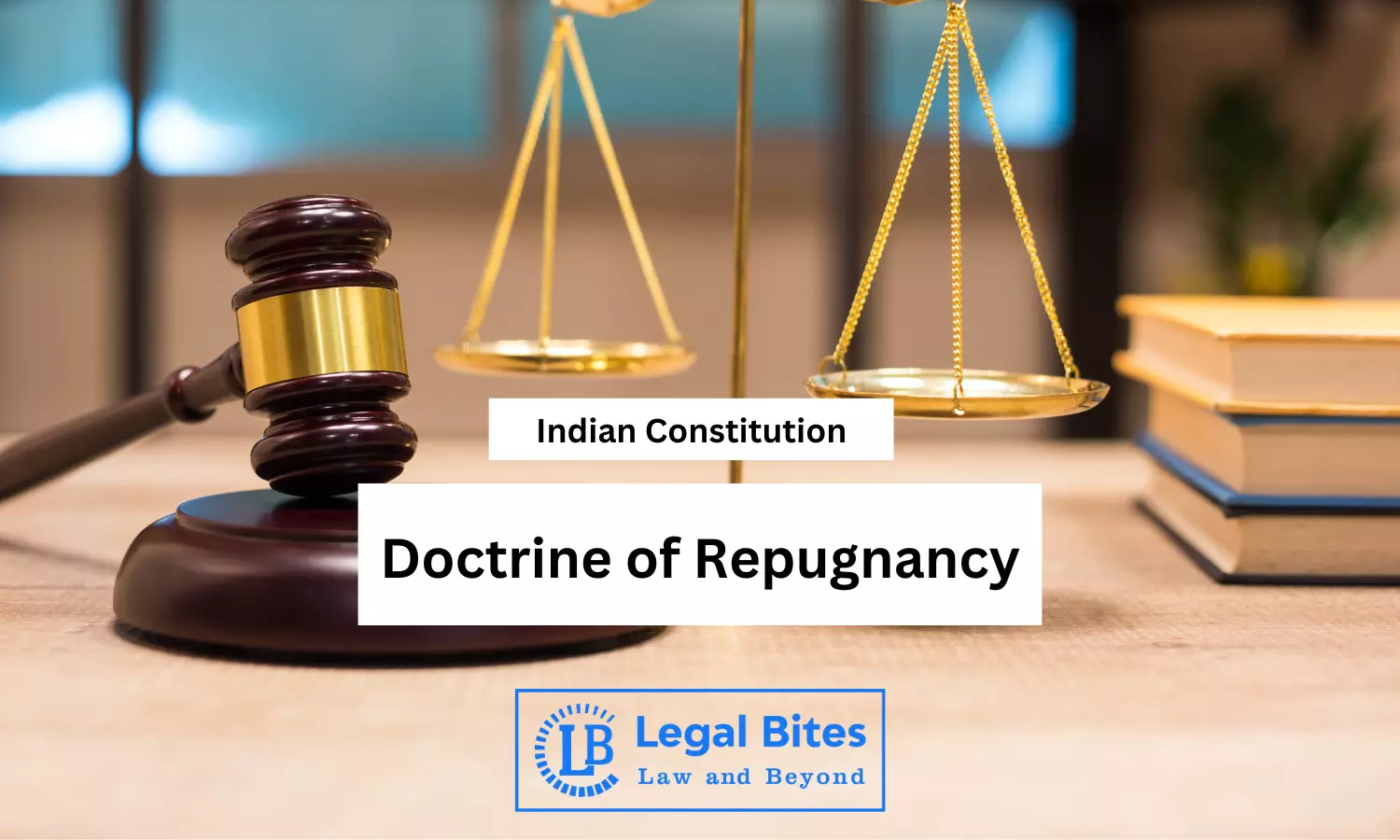This article, 'Doctrine of Repugnancy' demonstrates the meaning of this doctrine and its judicial interpretation.

This article, 'Doctrine of Repugnancy' demonstrates the meaning of this doctrine and its judicial interpretation. The article also encompasses the tests for determining the repugnancy of doctrine along with relevant case laws. This piece of work gives the readers knowledge about the applicability of the doctrine of repugnancy in detail.Introduction Initially, with 395 Articles, 12 Schedules, and 8 Parts, the Indian Constitution is the longest-written Constitution in the world. At present,...
This article, 'Doctrine of Repugnancy' demonstrates the meaning of this doctrine and its judicial interpretation. The article also encompasses the tests for determining the repugnancy of doctrine along with relevant case laws. This piece of work gives the readers knowledge about the applicability of the doctrine of repugnancy in detail.
Introduction
Initially, with 395 Articles, 12 Schedules, and 8 Parts, the Indian Constitution is the longest-written Constitution in the world. At present, the Indian Constitution consists of 448 Articles divided into 25 parts, 12 schedules. One of the basic tenets of Basic Structure is federalism. Although many jurists believed that the Indian Constitution was a combination of a unitary and a federal structure, it is characterised as a federal constitution because of the distribution of power between the Centre and the States. This federal arrangement frequently causes disagreement or collisions.
The process for dispute resolution between the Centre and the State Legislation issued with respect to any matter listed in List III of the Seventh Schedule is provided under Article 254 of the Indian Constitution in order to avoid conflict.
By virtue of numerous Articles read with Schedule VII, the Constitution of India, the nation's supreme law, grants the Central and State Governments the authority to enact legislation. Repugnancy is defined as an inconsistency or contradiction between two or more elements of a legal instrument by Black's Law Dictionary. Any discrepancy between the laws made by the Centre and the State can occur under a system where the ability to make laws is divided between the Centre and the States. To deal with such issues, the Constitution included the Doctrine of Repugnancy.
Meaning of Doctrine of Repugnancy
When two pieces of legislation clash and are applied to the same facts but result in different conclusions or outcomes, this is referred to as repugnancy. Repugnancy occurs when two laws' provisions are so incompatible and contradictory that it is difficult to act in one way without opposing the other. The Doctrine of Repugnancy is effectively established in India owing to Article 254 of the Indian Constitution.
According to Article 254, the doctrine of repugnancy states that if any part of State law is inconsistent with any part of a Central law that the Parliament has the authority to enact or any part of a law pertaining to a subject on List III, the Central law made by the Parliament shall take precedence and the law made by the State legislature shall be null and void to the extent of its inconsistencies.
According to Article 254(1), a law issued by Parliament will take precedence over legislation passed by the State legislature if one provision of law or a law made by the State legislature conflicts with another provision of law.
According to Article 254(2), if any provision of law or law made by the State legislature on the subject listed in the concurrent list conflicts with any provision of law or law made by the Parliament and if it was reserved for the President's assent and received the President's assent, the State law will take precedence over the law passed by the Parliament. As long as Parliament has the ability to change or remove the abhorrent law at any moment prior to the President's assent.
Judicial interpretation
In order to understand the court's view on this doctrine, it is imperative to understand some of the important landmark cases that contribute to making this doctrine more relevant and essential with regard to resolving conflicts in-laws of the State and Centre. Let us understand a few of the cases as followed:
1. M. Karunanidhi v. Union of India, (1979 AIR 898)
A constitutional bench of the Supreme Court examined the question of whether legislation passed by the State legislature and a statute passed by the Parliament were incompatible in this instance. It was noted that in order to apply the doctrine of repugnancy, the following requirements must be met: a clear discrepancy between the State Act and the Central Act must be present, the said contradiction must be incommensurable and; it should be difficult to obey one Act without also disobeying the other because of the discrepancy between its provisions, which should be severe enough to bring the two Acts into direct conflict.
The Honourable Court also established certain views in this regard. Two enactments must contain provisions that are so contradictory with one another that they cannot coexist in the same area in order for the theory of repugnancy to apply. It is not possible to repeal by implication unless the laws are inherently defective. This doctrine is not applicable if there are two laws in the same field that have the potential to operate independently of one another. The issue of repugnancy is not raised when there is no inconsistency but an act in the same area causes different offences.
2. Government of Andhra Pradesh v. J.B. Educational Society, (1998 (3) ALD 736)
In this decision, the Court made the observation that the judiciary must interpret laws passed by the State Legislature and the Parliament in a way that avoids or avoids the issue of conflict. However, the Parliamentary law shall have precedence if a disagreement between the two laws cannot be avoided.
The greatest potential for conflict arises in this situation since List III grants the State Legislatures and the Parliament equal authority to enact legislation. Once more, the Court should interpret the law to resolve the disagreement amicably or otherwise use the methods outlined in Article 245. The case where State legislation that has been reserved and received the President's approval prevails in that State is covered under Clause (2) of Article 254.
3. Hoechst Pharma Ltd. v. State of Bihar, (1982 51 STC 66 Pat)
The impact of Clause (2) of Article 254 is discussed in the case that follows. The Bihar drug manufacturing facility filed the appeal. They established a single wholesale facility in Patna after selling medications throughout Bihar. Drugs would first travel from the wholesaler to the retailer, then to the consumer. They sold 90–95 per cent of the graphs at a controlled price in accordance with the 1979 Drugs Order, made according to the Essential Commodity Act of 1955.
Section 2 of the Bihar Finance Act, mandates that anyone making a profit of more than 5 lacs through any commercial means must pay not more than an additional 10% on a sales tax out of their income and is not even permitted to collect that money from customers, was the subject of the writ petition filed by the appellant. It was noted that the President's approval of state legislation that conflicts with federal law for a topic relating to a concurrent subject is significant because it causes the state law in that state to predominate, invalidating the application of the statutory provision in that state alone.
Tests for Determining Repugnancy
In the case of Deep Chand v. State of Uttar Pradesh, 1959 AIR 648, the court stated that the following three tests can be used to determine if two enactments are repugnant to one another:
1. Whether the two incompatible clauses are directly at odds with one another.
2. Whether the Parliament intended to replace the State legislature's statute with an exhaustive enactment on the subject.
3. Whether the laws created by the State legislature and the Parliament address the same subject.
Let us try to decode these three essentials in detail:
Presence of 'Direct Conflict'
When two laws cannot be put into effect at the same time, it is argued that a direct contradiction exists. When one law precludes the application of another law to the same conduct, this is a clear instance of repugnancy. These facts were present in the Calcutta High Court case Mati Lal Shah v. Chandra Kanta Sarkar, (AIR 1947 Cal 1). Sections 20 and 34 of the Bengal Agricultural Debtors Act of 1936 and Section 31 of the Presidency Small Causes Courts Act of 1882, which is currently in effect in India, have a conflict.
The former demanded that a notice's service be suspended while certain judgements against agricultural debtors were being implemented.
Whether the Centre has attempted to implement an 'Exhaustive Code'
For complicated situations, the direct conflict test may seem to be too restrictive. A second principle emerged as a result, which states that if the Central government purposefully created a code for its exhaustive application for regulating the subject, then it would not be harmonious for the State legislation to operate concurrently. This principle was developed for a fuller understanding of the application of the dominant legislation. This test gives the judiciary plenty of room to maintain the paramount legislation's intended principles and disprove any specialised arguments that might be made in reliance on the direct collision test.
Whether the laws are on the same subject matter
This test closely resembles the exhaustive code test for determining incompatibility between two enactments. It would not be appropriate for state law to legislate in the same field if the central government had passed a law with the goal of controlling the entire sector. Therefore, it is very important to understand that for this doctrine of repugnancy to be applicable, there must be a similarity in the area in which those particular contradicting laws have been passed.
Conclusion
The Union Parliament and State Legislatures are given equal authority to enact legislation under the Indian Constitution. However, conflicts have occasionally arisen as a result of the Constitution's intricacy; for this reason, the Indian Constitution is referred to as "Federal with Strong Centralizing Tendency."
References
[1] Pankaj Sevta, Doctrine of Repugnancy, Available Here
[2] Suman Lakhani, 'Conceptual Comprehension of Doctrine of Repugnancy and its Empirical Enactment', Available Here
[3] Shashikant Saurav, 'Doctrine of Repugnancy', Available Here
[4] Ajoy Karpuram, 'Supreme Court Clarifies Stance on Repugnancy of Statutes', Available Here
[5] Darshit Hemang Vora, 'Constitutional Law: Doctrine of Repugnancy', Available Here
Important Links
Law Library: Notes and Study Material for LLB, LLM, Judiciary, and Entrance Exams

Snehil Sharma
Snehil Sharma is an advocate with an LL.M specializing in Business Law. He is a legal research aficionado and is actively indulged in legal content creation. His forte is researching on contemporary legal issues.
